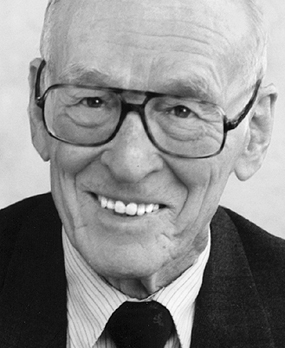How has he transformed the scene?
Now in his early 90s, Nobel prizing-winning bio-chemist Dr. Paul Boyer still remembers his first forays into chemistry in the basement of his family home, using a chemistry set he’d received as a Christmas gift. He also considers other influences on the direction his life has taken: his mother’s untimely death at age 45 from Addison’s disease (an adrenal insufficiency now imminently more treatable with modern research-based therapies), his father’s work as an osteopathic physician, his own self-professed “tendency to be lucky and make the right choices based on limited information.”
“Dr. Paul D. Boyer has devoted his career as a researcher and educator to unraveling riddles about fundamental chemical processes that affect all life.”
Chancellor Albert Carnesale, presenting Boyer with UCLA Medal, 1998
One of those choices was made while a student at Brigham Young University in his hometown of Provo, Utah. Nearing completion of his undergrad work in chemistry, he was considering possible career options—including hotel management—when he spotted a posting for a scholarship offered by the Wisconsin Alumni Research Foundation. Application accepted, Boyer soon found himself bound for the Midwest and a graduate studies program at the University of Wisconsin, Madison.
The bio-chem program at UW Madison was among the best in the country and Boyer was quickly immersed, in particular, with work on metabolism and enzymes. After earning his M.S. and Ph.D. at Madison (in 1941 and ‘43, respectively) he participated in a number of wartime projects, including work on blood plasma proteins at Stanford. Boyer and colleagues worked under the direction of J. Murray Luck to devise a stabilization method (still in use today) that prevents cloudiness from protein denaturation when serum albumen is heated to kill microorganisms and viruses.
In 1946 Boyer moved to Minnesota, where he taught and conducted research as an Assistant Professor in the University of Minnesota’s Department of Biochemistry. After a 1955 sabbatical for a Guggenheim Fellowship in Sweden, he returned to the U of MN to accept a Hill Foundation Professorship within the medical school campus. He describes the time as “a golden era for biochemistry,” when lively minds came together to address compelling questions in a climate of strong national funding support for research.
Whatever the cost of the chemistry set given to young Paul Boyer in the 1920s, it was surely worth it.
Boyer’s work yielded not only insights into processes at the molecular level, but new means of inquiry, including kinetic, isotopic and chemical methods. His investigations continued to focus on enzymes, including efforts to fully understand the still elusive process of oxidative phosphorylation, by which living things obtain energy for metabolism as well as cellular processes such as muscle contractions and transmission of nerve messages. More precisely, Boyer sought to discern the enzymatic mechanisms supporting the role of the nucleotide ATP, sometimes called ‘the energy currency of life.’ It was a classic question at the heart of the field of biochemistry, and one of the great mysteries of science.
The year 1963 brought a change of venue as Boyer accepted a professorship in bio-chemistry at UCLA and soon after was appointed to a position as founding Director of the University’s new Molecular Biology Institute. It would be here, in southern California, that Boyer’s investigations into the role of ATP would come to fruition. In 1971, Boyer and his team of researchers made an exciting breakthrough when they recognized the first of three postulates explaining the role of ATP that together form what is now universally known as the binding change mechanism for ATP synthesis.
Boyer articulates these three postulates as follows: 1) Energy input is not used primarily to form the ATP molecule, but to promote the release of an already formed and tightly bound ATP. 2) Three catalytic sites (on the key enzyme ATP synthase) participate sequentially and cooperatively, and 3) The data from his team and that of others could be best explained by what is termed a ‘rotational catalysis.’
The latter postulate was an especially novel concept that the scientific community was slow to accept. Boyer was essentially proposing that an internal subunit served a coordinating function not unlike a camshaft in a car, rotating in such a manner as to cause the three catalytic sites to be in different conformations at any one time, while all were progressing through the same three-step operation resulting in release of ATP. Could it be true? The postulate was broadly embraced only years later, when its efficacy was clearly demonstrated in separate studies by researchers in England and Japan.
In short, the concepts of Boyer’s binding change mechanism helped to clarify the basic chemistry of life on earth, what makes life “go.” They illuminated a greater understanding of the beautiful complexity of the world around—and within—us all.
In 1997, Dr. Paul Boyer was awarded the Nobel Prize in Chemistry for elucidation of the enzymatic mechanism underlying the synthesis of adenosine triphosphatase. His work opened entire new fields of scientific study in biochemistry, molecular biology, and nutrition, generating a remarkable body of knowledge with immeasurable positive impacts on society.
Boyer acknowledges with appreciation the contributions of individuals who have been part of his research efforts: “I believe that the best research,” he notes, “is accomplished by a faculty member with a small group of graduate students and postdocs, who freely design, competently conduct and intensely evaluate experiments.”
Boyer presently serves as Professor Emeritus and maintains an office at UCLA’s Department of Chemistry and Biochemistry. As his colleagues in the scientific community know, Dr. Boyer’s Nobel Prize was a highlight, but fails to capture the breadth or depth of this man’s contributions. In addition to his lifetime body of research, he has written and published widely (including editing of the classic 18-volume series The Enzymes”), has shared his expertise and guided aspiring scientists in university settings, and has provided his leadership and insight through America’s most prestigious scientific institutions.

